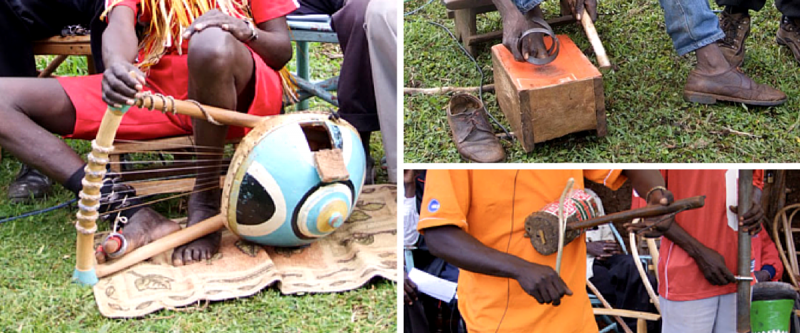During our recording trips around Kenya – which have taken us over the years to the coast, the west and the central regions – we’ve come across a broad range of fascinating musical instruments played with impressive confidence and mastery by the communities that created them. Since many of these instruments are all but unknown outside certain Kenyan ethnic groups, we wanted to share what we’ve learned about a few of the most interesting and unique.
You can read more about the trips on which we encountered these instruments, and some of the stories behind them, in our field reports.

Lungo and Ndema
We heard both the Lungo (broken glass moved around in a big bowl) and Ndema (two brass rings played in ringing and muted tones) back in 2011, when we ventured out to the coastal village of Sita near Malindi. At the time Sita didn’t have much more than seven houses, two cows and lots of chickens, but it was home to the wonderful Nyerere wa Konde Music Club. The club included a percussion trio playing the Lungo and the Ndema, as well as two shakers and a Filimbi (a type of whistle). Listen here:
Nyatiti
The Nyatiti is a stringed Luo instrument which, in the hands of the masters, serves as a bass, drum and rhythm guitar combined. One of the most famous Nyatiti players of all time is Ayub Ogada, seen here playing “Kothbiro”:
We were lucky enough to meet the Joginda Boys in 2011 in Siaya, where we witnessed Organda Joginda simultaneously playing “bass” with the Nyatiti, percussion with his leg “snares” and the kick drum with his big toe (wearing a metal ring) banging on the bottom of the Nyatiti. The rest of the band joined in clapping, dancing and providing wonderful backing vocals:
Orutu
After the Nyatiti, the Orutu is the second most important instrument in Luo music (though we also encountered it in central Kenya, where it’s called the Wandindi). When well-played, it takes on the role of the “fiddle” found in Irish or American country music. The Orutu is a one-string instrument played with a bow, whose notes are created by finger pressure against the central stick, producing the effect of ‘fretting’ notes. Watch here as the Aloka Ohangla Group plays “Nyar Karapul” (the Orutu is on the far left):
Nyangile
The Nyangile is a Luo instrument whose name literally means “box.” To play it, a musician holds two metal rings called “ogeng’”, one in his right hand, one with his right big toe. Both are placed on a wooden box. With his left hand he hits either ogeng’ (each with a different sound), or the side or top of the box (which also produces different sounds). He also has the option of sliding the rings along the top as he plays to elongate the note and change its pitch, making the instrument sound more like a bass.
We were treated to an impressive Nyangile performance by a group called The Young Stars in the village of Rongo, not far from Homa Bay in western Kenya. Watch them here:
Burkandit
The Burkandit is a type of home-made guitar that features in Kalenjin music. We saw one being played in 2012 by the masterful Ben Kisinja in Kapsokwony, not far from Kitale. At the time Ben was joined by a percussionist playing the karachimek, which is essentially two sticks laid on the ground and played by two more sticks.
Of course there are so many more amazing instruments that we’ve recorded, and more still to find. To learn more about East Africa’s traditional musical instruments, have a look at our instruments page here.
